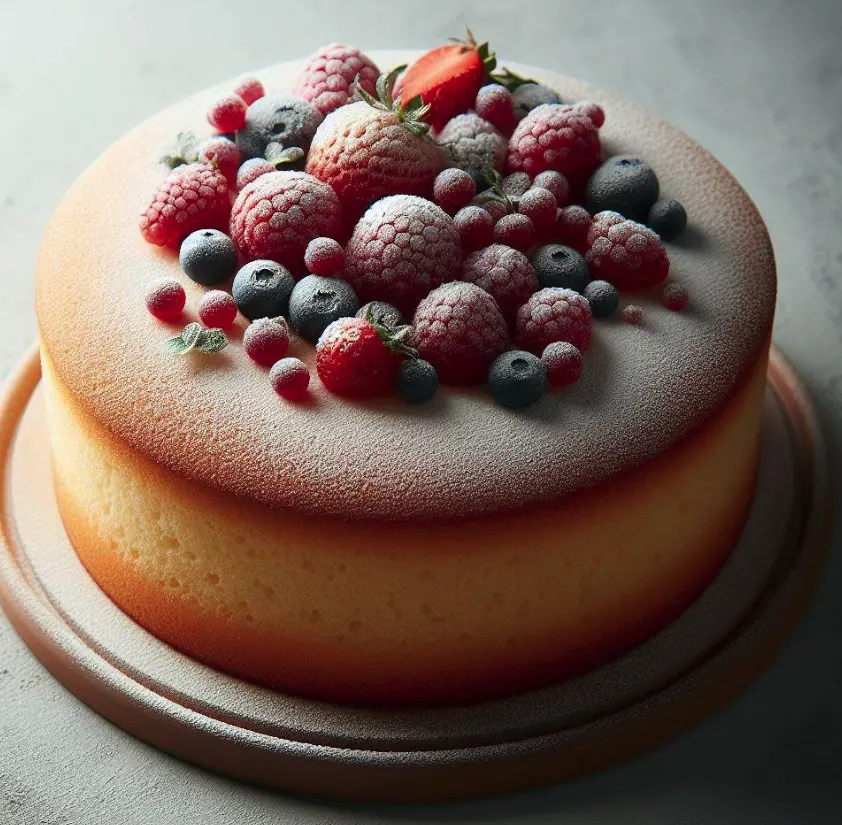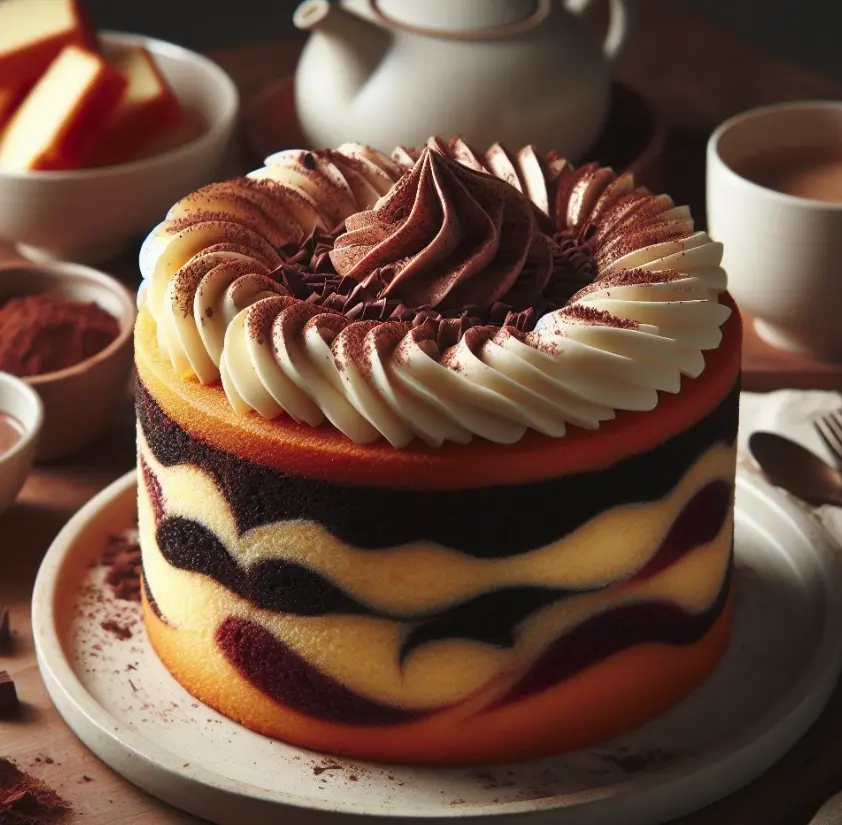Caribbean Calling: The Trinidad Sponge Cake Story
Once you take your first bit of Trinidad sponge cake, you’ll be hooked instantly! This delicious cake has its roots deeply embedded in Trinidad culture, especially during the festive Christmas season. When families gather around the table, the Trini sponge cake, often referred to by locals simply as the “sponge,” is a must-have. Many claim it’s the Caribbean dessert favorite, boasting a light cake texture. It’s no surprise that the Trinidad sponge cake recipe has stood the test of time, being passed down through generations.
However, what makes this cake truly special is its adaptability. While the basic sponge cake recipe remains consistent, Trinidadian households often infuse it with different flavors, from the zesty lime to the sweet tonka bean.
The versatility of this cake means it can be paired with a scoop of ice cream, a drizzle of melted chocolate, or simply enjoyed on its own.
And, for those curious about its origin, the Trini sponge cake is a delightful blend of Caribbean recipe traditions and colonial influences. It’s a simple recipe, but with a flavor and texture that captures the essence of Trinidad’s vibrant culture. And you know that at Kitchen Easy Life, we’re all about easy recipes and delicious meals.
This recipe really takes the cake on both qualities (pun intended!). Over time, it has evolved, with each family adding its unique touch, making it a cherished part of Trinidad heritage. We hope that by the end of this post, you’ll be armed with all the necessary knowledge to make this amazing cake at home using our best-ever Trinidad Sponge Cake recipe! Ready?!

Egg-citing Ingredients: The Building Blocks
At the heart of the Trinidad sponge cake recipe is a list of humble yet crucial ingredients. Room temperature eggs ensure a fluffy texture, while vanilla essence (or almond essence for some) adds a delicate aroma.
A mix of purpose flour and baking powder forms the flour mixture, providing the cake its structure. And let’s not forget the softened butter, which when creamed with sugar, gives the cake its rich taste.
In a separate bowl, dry ingredients are sifted to remove any lumps, ensuring a smooth batter. For those wanting to add an extra flavor punch, lemon zest or orange zest can be incorporated.
Some families even add a dash of cinnamon powder for that festive touch. While these ingredients form the base of the actual sponge cake, the real magic lies in how they are combined.
For a twist on the original recipe, some bakers like to experiment with milk mixture variations. This can include a combination of pineapple juice for a tropical flavor or orange juice for a citrusy punch. The key is to balance the wet ingredients with the dry, ensuring a perfect bake every time.
Whisked Away: Mastering the Mixing Technique
The first thing to know is that the method makes the magic. In a large bowl, using an electric mixer cream butter and sugar until it’s pale and fluffy. This process aerates the mixture, giving the cake its signature fluffy cake consistency. Once creamed, egg whites, previously separated, are beaten at high speed until soft peaks form. These are then folded gently into the butter mixture, ensuring no air bubbles remain.
In a medium bowl, the dry ingredients are whisked together. This includes the flour mixture, with some bakers opting for cake flour for an even lighter cake. To this, lemon juice or even a hint of lime zest can be added for that tangy kick.
The trick here is to alternate between adding the dry ingredients and wet, like the milk mixture or orange juice. Using a rubber spatula, ensure the sides of the bowl are scraped down, incorporating every bit.
Lastly, pour cake batter into baking pans lined with parchment paper. For those with a wild side, why not try a marble sponge cake? By swirling in some melted chocolate into half the batter, a delicious marble cake recipe is born. The batter should be spread evenly, ensuring it reaches the sides of the pan, ready for a perfect bake.
Baking Bliss: Oven Tips and Tricks
As with most baking recipes, preparation is key. Before you even think of pouring your batter, ensure you have a preheated oven, ideally a Fahrenheit oven for precision. The baking pans, preferably round cake pans, should be prepped too, either greased with coconut oil or lined with parchment paper for easy removal post-baking. When it comes to placing your cake, the center of the cake should align with the middle rack of the oven, ensuring even heat distribution.
Baking is a science, and the oven door should remain firmly shut during the initial stages of baking. No peeking! Use a wooden pick or a thin knife to check the center of the cake. If it comes out clean, your masterpiece is ready.
For those using different flavors or additional ingredients like melted chocolate, a longer bake time might be required.
Once baked to golden perfection, the cake needs to cool. Remove from the oven and let it sit for a short while. Then, using a butter knife, gently go around the sides of the pan to loosen the cake. Invert onto a wire rack and let it cool completely. The result? A homemade sponge cake, Trinidad-style, that’s a testament to great recipes and even better baking skills.
Tots Takeover: Kid-Friendly Baking Fun
There’s nothing quite like the bonding experience of baking with your little ones, especially when you’re whipping up a Trinidad sponge cake recipe! First things first, let’s lay out our work surface with all the ingredients. Now, here’s a pro-tip: for this cake, it’s essential that ingredients like the butter and eggs are at room temperature. It ensures a fluffy texture that’s synonymous with a great Trini sponge cake.
Let your kiddos take charge of measuring the flour mixture and other dry ingredients in a separate bowl. Make it educational by teaching them about measurements, and let them marvel at the magic of baking powder transforming a simple recipe into a Caribbean dessert favorite.
Now, for the fun part! Allow the tiny hands to cream sugar and butter in a large bowl. With an electric mixer, cream butter and sugar until they’re light and fluffy. You’ll then want to add in vanilla essence and almond essence for that extra flavor kick.
The egg mixture is next, and while kids love cracking eggs, remember to keep an eye out for any rogue shells. At the Kitchen Easy Life kitchen, we always crack eggs into a separate bowl before adding them to the rest of the wet ingredients just in case you have a bad egg or want to avoid shells.
Once the wet ingredients are mixed well, the young chefs can slowly incorporate the dry ingredients. The final batter should have no air bubbles, and if you’re feeling adventurous, adding some orange zest or lemon zest can give the cake a delightful citrusy twist.
Finally, pour cake batter into round cake pans lined with parchment paper. This is a step where kids absolutely beam with pride, seeing their hard work ready to be transformed in the preheated oven! Place it on the middle rack and watch as the cake rises, with its golden hue promising a delicious cake experience. Once baked, let it cool on a wire rack before indulging.
And remember, while this is a basic sponge cake recipe, the memories created during the process are anything but basic!
Twists and Turns: Modern Takes on the Classic
While the Trinidad sponge cake recipe is a timeless Caribbean gem, there’s always room for a sprinkle of innovation! Ever thought of creating a marble sponge cake?

Begin with the basic sponge cake recipe, but separate half of the batter into a medium bowl. Add melted chocolate to this, and voila, you have a chocolate batter ready! Pour batter alternately into the baking pans, and with a butter knife, swirl the two for that marbled effect.
This delicious marble cake recipe is sure to be a hit for those craving a mix of vanilla and chocolate.
The Christmas season in Trinidad is synonymous with the black cake, but why not infuse some of that festive spirit into our sponge cake?
Lime zest and a hint of cinnamon powder can elevate the plain sponge cake into a Christmas delight.
You can also replace the vanilla extract with pineapple juice or orange juice for a tropical twist.
Another popular variant is to fold in some grated coconut or drizzle with coconut oil.
The beauty of this Trinidad sponge cake recipe is that it can go with nearly any flavor combination out there! Different flavors and varying ingredients, yet the soul of this Caribbean recipe remains intact.
But what if you’re looking to surprise your guests? A hidden center is always a showstopper! Once the cake is baked and cooled, cut out a small circle from the center of the cake.

Fill this with ice cream or even a surprise candy stash. Cover it back with a slice from the cake top, and when your guests dive in, their expressions will be priceless!
Slice of Heaven: Serving and Presentation
So, you’ve baked the perfect Trinidad sponge cake! Now bask in the aroma that fills your kitchen! But hey, not too long! It’s time to plate this beauty! Presentation, as they say, is everything.
First, ensure that your cake has completely cooled. Transferring it onto a beautiful cake stand or plate can elevate the visual appeal. A light dusting of powdered sugar can give it a snow-kissed look, perfect for any special occasion.
Now, let’s talk garnishing. Fresh fruits, especially berries, can add a pop of color against the golden brown of the cake. Edible flowers are another elegant option. If you’re in the mood for some decadence, a drizzle of melted chocolate or a dollop of fresh cream can never go wrong. For those who love a hint of citrus, a simple syrup made of lemon juice and powdered sugar, drizzled over the cake, can be refreshing.
Finally, the proof of the pudding, or in this case, the Trinidad sponge cake recipe, is in the eating. Slice it up using a butter knife or a thin knife, ensuring each slice showcases the fluffy cake in all its glory.
Cake Conversations: Frequently Asked Questions
There are always a few hiccups along the way to baking your masterpiece, but let’s address them head-on.
Many beginners wonder why their cake isn’t achieving that desired fluffy texture. One of the culprits could be not incorporating the dry ingredients properly. Using a rubber spatula to fold the flour mixture into the wet ingredients can help keep the batter light. Another common query is about the center of the cake remaining a tad undercooked. This could be because the cake is placed too high in the preheated oven. Make sure it’s on the middle rack to ensure even baking.
Now, you might be thinking of giving this Trini sponge cake a citrus twist. Lemon zest or orange zest are delightful additions, but remember to add them to your wet ingredients in a separate bowl before combining them with the dry ones. And while we’re on the topic of zest, a splash of lemon juice or orange juice can add a tangy freshness that complements the basic sponge cake recipe.
FAQs
What is the Secret of Sponge Cake?
Eggs
- Whole Eggs: The foundation of fluffiness.
- Separation Technique: Yolks and whites beaten separately.
- Temperature: Room temp eggs work best.
Flour Power
- Sifting Matters: Aerates for lightness.
- Gentle Folding: Maintains air in the batter.
Baking Wisdom
- Just Right Oven: Preheating is a must.
- No Peeking: Keep that oven door closed.
What is the Difference Between Cake and Sponge Cake?
| Feature | Cake | Sponge Cake |
|---|---|---|
| Texture | Denser, richer | Lighter, airier |
| Fat Content | Higher (butter/oil) | Lower (often none) |
| Rising Agent | Baking powder/soda | Whipped eggs |
| Moisture | Moist from fat | Moist from eggs |
What are the 4 Types of Sponge Cakes?
- Biscuit: Crisp and light.
- Genoise: French elegance, buttery.
- Chiffon: Oil for moisture.
- Angel Food: Heavenly egg whites only.
What Makes a Sponge Cake Moist?
Moisture Magic
- Eggs Galore: Natural moist makers.
- Sugar Balance: Not just sweet, but moist.
- Milk Matters: Adds tenderness.
- Syrup Soak: Post-bake moisture boost.
What to Avoid When Making Sponge Cake?
Common Sponge Cake Mistakes
- Overmixing: The fluffiness thief.
- Cold Eggs: They resist whipping.
- Rushing the Process: Patience is key.
- Improper Baking: Too hot, too cold.
- Eager Decorating: Let it cool first.
Our Cake Goodbye
Now that you know the history of this special cake and the steps on how to make it, we hope you’ll give it a try! Baking, especially something as iconic as this cake, isn’t just about following a simple recipe. It’s about pouring love, care, and sometimes a sprinkle of lime zest, into every step.
The Trinidad sponge cake stands out, not just for its fluffy texture but also for the memories it evokes—of Christmas time, family gatherings, and special occasions. Once you make it, you’ll feel it, too!
Share your experience with us! And, be sure to share this recipe with other home cooks that crave a taste of a great cake!
best Trinidad Sponge Cake Recipe
Course: DessertCuisine: TrinidadDifficulty: Medium8
servings30
minutes50
minutes300
kcalThis cake is perfect for special occasions, family gatherings, or simply when you’re in the mood for a delicious treat.
Ingredients
2 cups granulated sugar
1 cup unsalted butter, softened (room temperature)
4 large eggs (room temperature)
3 cups all-purpose flour
3 tsp baking powder
1/2 tsp salt
1 cup whole milk (room temperature)
1 tsp vanilla essence or vanilla extract
Zest of 1 lime or lemon
Optional: A dash of almond essence for added flavor
Directions
- Preparation: Preheat your oven to 350°F (175°C). Grease a round cake pan (about 9-inch) with softened butter or coconut oil. You can also line the bottom with parchment paper for easier removal.
- Cream Sugar and Butter: In a large bowl, using an electric mixer or hand mixer, cream together the cup butter and granulated sugar until the mixture is pale and fluffy. This step is crucial for a light cake texture.
- Egg Incorporation: Add the eggs one at a time, beating well after each addition. Ensure they’re fully integrated before adding the next. Add in the vanilla essence and mix well.
- Dry Ingredients: In a separate bowl, sift together the all-purpose flour, baking powder, and salt. This ensures there are no lumps and helps in getting a smoother cake batter.
- Alternate Additions: Gradually add the dry ingredients and milk to the butter mixture, starting and ending with the dry ingredients. This means you’ll add a third of the flour mixture, half of the milk, another third of the flour, the remaining milk, and finish with the flour. This method ensures even mixing without overworking the batter.
- Add Zest: Fold in the zest of lime or lemon using a rubber spatula. This adds a subtle Caribbean twist to the flavor.
- Pour and Bake: Pour the cake batter into the prepared round cake pan, ensuring it’s spread evenly. Tap the pan lightly on the work surface to release any air bubbles.
- Baking: Place the cake in the center of the preheated oven and bake for 45-50 minutes or until a wooden pick or thin knife inserted into the center of the cake comes out clean. Baking times might vary slightly based on oven variations, so keep an eye out!
- Cooling: Once baked, remove the cake from the oven and let it cool in the pan for about 10 minutes. After this, transfer it to a wire rack to cool completely.
- Serving: Slice the cooled cake using a sharp knife or cake slicer and serve. You can also sprinkle some powdered sugar on top for decoration if desired.
Notes
- Experiment with other flavors: fresh fruit, caramel, chocolate drizzle, etc.
Craving more delicious recipes? Try these: Cheesecake Factory Copycat Chicken and Biscuits

